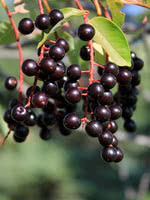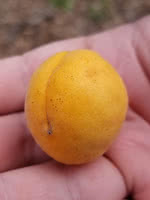Mon-Fri 9am - 5pm Mountain time
Western Chokecherry vs Manchurian Apricot
Prunus virginiana var. demissa
Prunus armeniaca var. mandshurica
SOLD OUT
Western Chokecherry is a shrub or small tree commonly used for farmstead and field windbreaks.
It produces white flowers in the spring and edible dark purple fruit that matures between September and October. Its cherries are great for making for making jams, jellies or wine, but are not very palatable for raw eating.
Manchurian Apricot is a winter-hardy relative of the native plum. This tree can stand some drought, but will not handle standing water or saturated moist soils. It can be used in shelterbelts, hedges, or as an ornamental. Manchurian Apricot will also attract songbirds, rabbits, and other rodents if left uncontrolled.
This tree will produce fruit once it reaches maturity at between two and five years old. Other famous cultivars of Manchurian Apricot include Scout Apricot, Moongold, and many more.
Western Chokecherry Quick Facts
Manchurian Apricot Quick Facts
Toxicity: toxic to horses, cattle, etc.)

